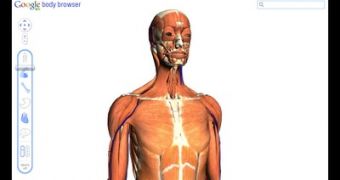Here's another Google Labs casualty that ended up a success story, or, at least, ended up surviving, Google Body, or Body Browser, an impressive WebGL demo that provides a model of the human body, complete with internal organs, bones and so on, in the browser.
Google has announced that, while it won't be maintaining the project itself, it will be open sourcing the code behind it and is working with another company to release a new application based on Google Body, which will be offered for free.
"We are working on open-sourcing the code that powers Google Body so that anyone will be able to create and run a searchable 3D viewer," the project's Labs page reads.
"We are also working with our partner, Zygote Media Group, on an application called Zygote Body," it said.
"This application will be free, available on the web and on Android, and will enable students, teachers, and others using Google Body to continue to have access to a human anatomy browser," it explained.
Google Body Browser debuted last year, in December, along with Google Chrome 9, which brought support for WebGL, enabled by default. To showcase what 3D graphics could mean for the open web, Google created the Body Browser.
The tool is quite impressive and can be a fun way of finding out what our body is made up of. It should be quite useful in schools too. Which is why Google is working on keeping it alive.
"Google Body is a detailed 3D model of the human body. You can peel back anatomical layers, zoom in, and navigate to parts that interest you. Click to identify anatomy, or search for muscles, organs, bones and more," Google detailed.
Out of the many Google Labs experiments, Body Browser isn't what you'd consider crucial and Google was probably not going to spend too much resources and time on it moving forward. Having it available as an open source project ensures that others interested in it can continue to improve and expand it. [via GoogleOS]

 14 DAY TRIAL //
14 DAY TRIAL //